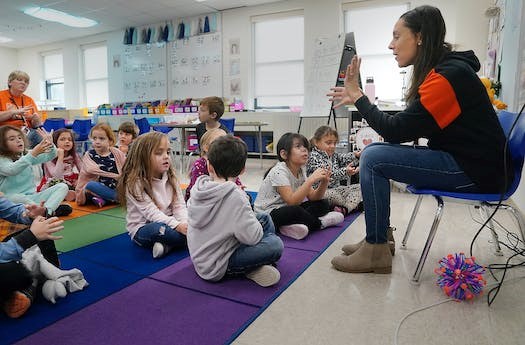
By Jenny Berg Star Tribune
Monday December 19, 2022
The central Minnesota district will also expand its Spanish immersion program to a second elementary school next year.

DAVID JOLES, STAR TRIBUNE
Spanish immersion teacher Marita Schmitz does the itsy-bitsy spider with her kindergarten students at the St. Cloud school district’s Clearview Elementary School in Clear Lake, Minn., on Dec. 9.
ST. CLOUD — A familiar melody spilled out of Marita Schmitz's kindergarten classroom one morning earlier this month. Inside, while sitting on a multicolor mat at the front of the room, children used their fingers and arms to demonstrate how a spider climbs up a waterspout just to be washed away by rain.
But instead of singing about an "itsy bitsy spider," the little voices sang of "la araña."
The students, most of whom are native English speakers, spend their school days learning the same curriculum as students in typical kindergarten classes, except nearly everything is taught in Spanish.
"The first few days, their eyes are like this," Meredith Boucher, principal at Clearview Elementary School in Clear Lake, Minn., said, demonstrating a worried face with gaping eyes. "But by December, their teacher will be able to speak to them fully in Spanish."
The St. Cloud school district has offered Spanish and Chinese immersion programs for more than a decade. Next year, the district will expand the program to reach even more students by offering a Somali immersion program thought to be the first in the country.
The current Spanish immersion program will also expand to two elementary schools in the district and transition from full immersion to dual immersion, meaning the students will spend half the day learning in Spanish and the other in English. The move to dual immersion follows national trends based on research showing students who speak two languages have longer attention spans and better problem-solving skills.The Somali immersion program will be structured the same way, with students spending half the day learning in Somali and English, respectively. District leaders anticipate about half the students in each program to be native Spanish or Somali speakers and the other half native English speakers.
"Forty percent of our incoming kindergartners speak a language other than English — primarily Somali and Spanish — and so we want to be really intentional about creating programming that honors the gifts that all of our kids bring," said Laurie Putnam, superintendent. "It's a unique opportunity in central Minnesota. We want to be the immersion provider."
Two years ago, the district spearheaded a high school language course for native Somali speakers also thought to be the first in the nation. And last year, the school board approved adding two new high school language courses: Somali and Ojibwe for nonnative speakers.
"Programs like this play a critical role in giving students spaces that affirm their identify, their cultures and who they are. That's a big piece of learning," said Abdikadir Bashir, director of the nonprofit Center for African Immigrants and Refugees Organization, which started as a group tackling academic achievement disparities in Oregon and has since expanded to Minnesota.
Bashir is one of the community partners helping the district find resources to create a curriculum for the Somali immersion program. He said the program is important in addressing education inequities in Minnesota — which has had some of the most severe educational disparities in the nation for students of color — because it should bolster writing and language skills in the students' native language and English.
That should, in turn, lead to better academic outcomes and improve graduation rates, as well as foster understanding in a growingly diverse community.
The school board approved the new immersion program in November. Board member Natalie Copeland Ringsmuth, who serves on the curriculum committee, said district leaders have been talking about adding a Somali immersion program for years and she's excited it is finally happening.
"This is just us playing to our strengths — and the joy of who we are as a multilingual district," she said.
About 60% of the nearly 9,500 students in the central Minnesota school district are students of color — a big change from a decade ago when one in four students were students of color. About 42% of students are Black and about 23% are English learners, meaning English is not their native language.
Research has found dual immersion programs are beneficial for students regardless of their native language, said Lori Posch, director of learning and teaching for the district.
"I just believe so wholeheartedly in what being multilingual does for brain development and for creating children and students who are connected to cultures outside of our own," she said.
About three dozen school districts and charter schools in Minnesota offer immersion programming, according to the Minnesota Advocates for Immersion Network, and a majority of those are Spanish programs. The cost of staffing and curriculum, as well as a lack of available space in schools, could be reasons why more districts don't offer immersion programs, Posch said.
The first-in-the-nation courses could change how language and culture is taught in Minnesota schools. But for Posch, the reasoning behind adding the new courses is that they simply make sense for the district.
"We've created a culture where our students come first," she said.